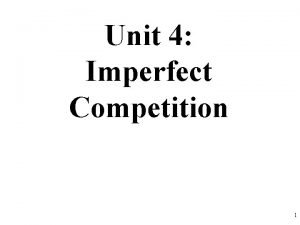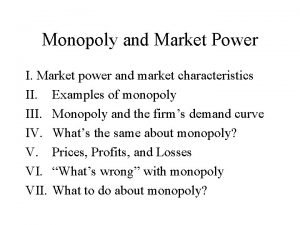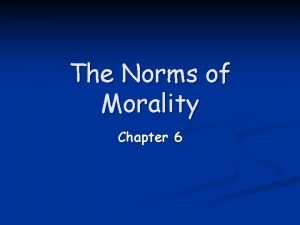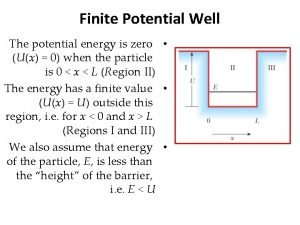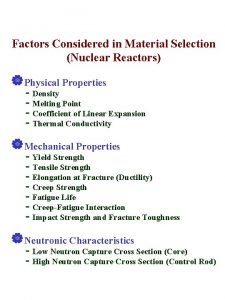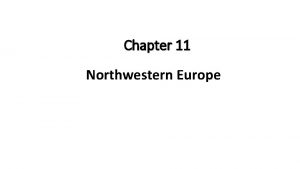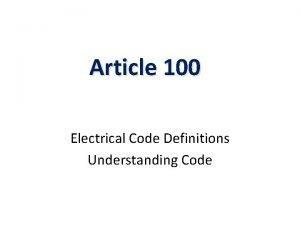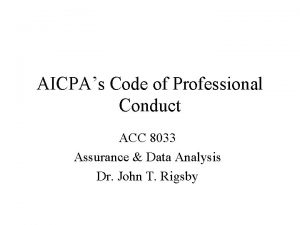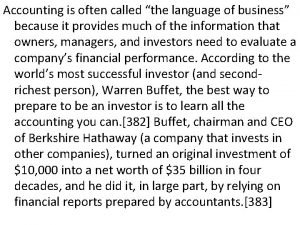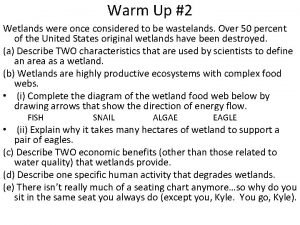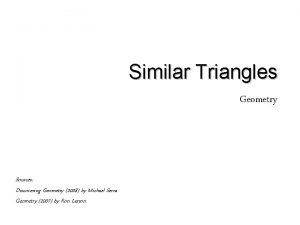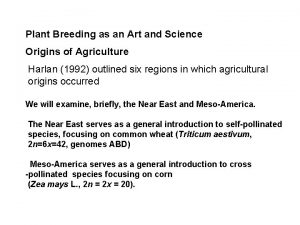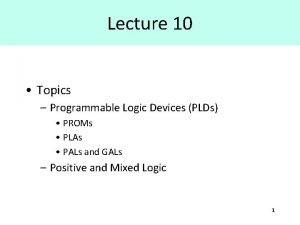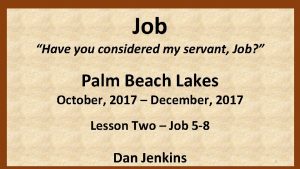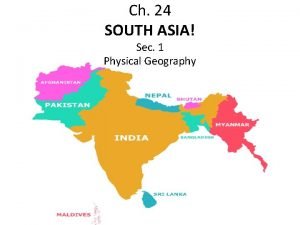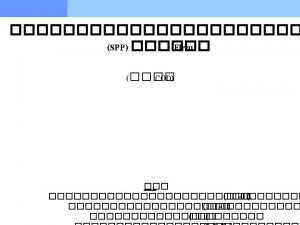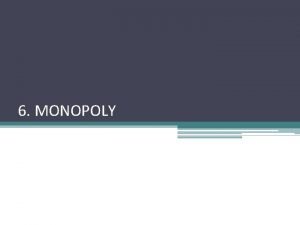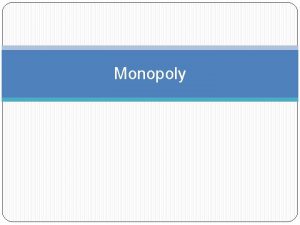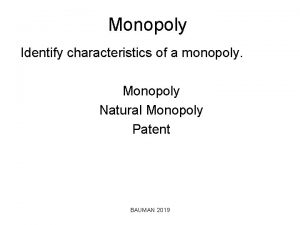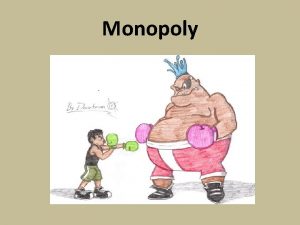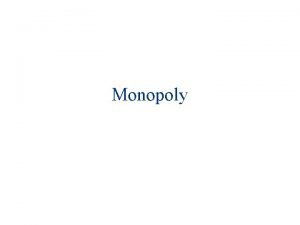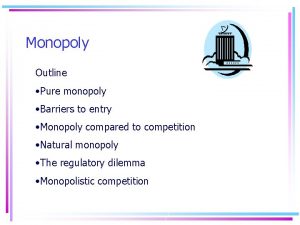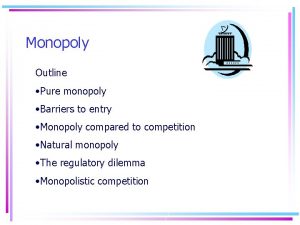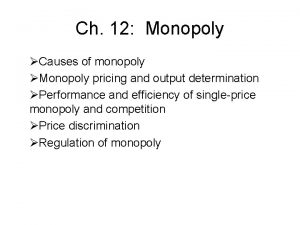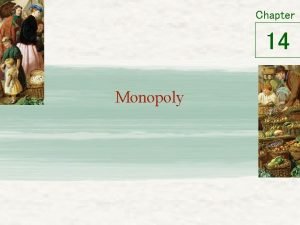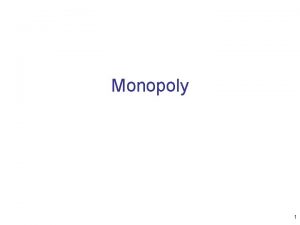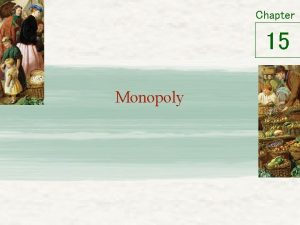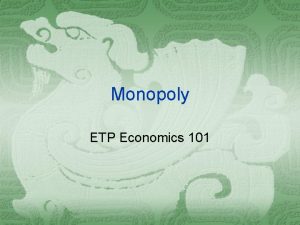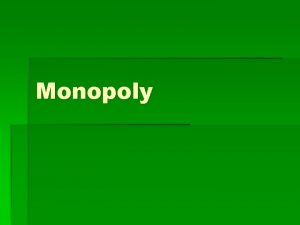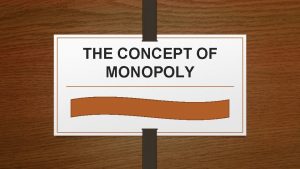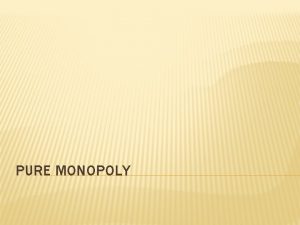Monopoly Characteristics A firm is considered a monopoly















































- Slides: 47

Monopoly - Characteristics • A firm is considered a monopoly if. . . it is the sole seller of its product. . its product does not have close substitutes. . it has some ability to influence the market price of its product.

Why Monopolies Arise • • The fundamental cause of monopoly is barriers to entry. Barriers to entry have three sources: äOwnership of key resource äLegal barriers by government äLarge economies of scale • Exclusive ownership of an important resource that cannot be readily duplicated is a potential source of monopoly.

Government-Created Monopolies • • Patent and copyright laws are a major source of government-created monopolies. Governments also restrict entry by giving a single firm the exclusive right to sell a particular good in certain markets.

Natural Monopolies • • An industry is a natural monopoly when a single firm can supply a good or service to an entire market at a smaller cost than could two or more firms. Because of economies of scale, the minimum efficient scale of one firm’s plant is so large that only one firm can supply the market efficiently.

Monopoly versus Perfect Competition • Monopoly äIs the sole producer äHas a downwardsloping demand curve äIs a price maker äReduces price to increase sales • Competitive Firm äIs one of many producers äHas a horizontal demand curve äIs a price taker äSells as much or as little at same price

Monopoly’s Revenue • Total Revenue P x Q = TR • Average Revenue TR/Q = AR = P • Marginal Revenue DTR/DQ = MR NB : - MR does not equal AR

Monopoly’s, Total, Average, and Marginal Revenue

Monopoly’s Marginal Revenue • A monopolist’s marginal revenue is always less than the price of its good. äThe demand curve is downward sloping. äWhen a monopoly drops the price to sell one more unit, the revenue received from previously sold units also decreases.

Monopoly’s Marginal Revenue • When a monopoly increases the amount it sells, it has two effects on total revenue (P x Q). äThe output effect—more output is sold, so Q is higher. äThe price effect—price falls, so P is lower.

Monopoly’s Demand Marginal Revenue Curves Price £ 11 10 9 8 7 6 5 4 3 2 1 0 -1 -2 -3 -4 • The marginal revenue curve lies below its demand curve. Demand (average revenue) Marginal revenue 1 2 3 4 5 6 7 8 Quantity of Water

Profit Maximization of a Monopoly • • A monopoly maximizes profit by producing the quantity at which marginal revenue equals marginal cost. It then uses the demand curve to find the price that will induce consumers to buy that quantity.

Profit Maximization of a Monopoly Costs and Revenue Marginal cost Average total cost Demand Marginal revenue 0 Quantity

Profit Maximization of a Monopoly Costs and Revenue Marginal cost Average total cost A Demand Marginal revenue 0 Quantity

Profit Maximization of a Monopoly Costs and Revenue 1. The intersection of the marginal-revenue curve and the marginal-cost curve determines the profit-maximizing quantity. . . Average total cost A Marginal cost Demand Marginal revenue 0 Quantity

Profit Maximization of a Monopoly Costs and Revenue 1. The intersection of the marginal-revenue curve and the marginal-cost curve determines the profit-maximizing quantity. . . Average total cost A Demand Marginal cost Marginal revenue 0 QMAX Quantity

Profit Maximization of a Monopoly Costs and Revenue 2. . and then the demand curve shows the price consistent with this quantity. B Monopoly price 1. The intersection of the marginal-revenue curve and the marginal-cost curve determines the profit-maximizing quantity. . . Average total cost A Demand Marginal cost Marginal revenue 0 QMAX Quantity

Comparing Monopoly and Competition • For a competitive firm, price equals marginal cost. P = MR = MC • For a monopoly firm, price exceeds marginal cost. P > MR = MC

Calculating Monopoly Profit • Profit equals total revenue minus total costs. Profit = TR - TC Profit = (TR/Q - TC/Q) x Q Profit = (P - ATC) x Q

The Monopolist’s Profit Costs and Revenue Marginal cost Monopoly price Average total cost Demand Marginal revenue 0 QMAX Quantity

The Monopolist’s Profit Costs and Revenue Marginal cost Monopoly price Average total cost Demand Marginal revenue 0 QMAX Quantity

The Monopolist’s Profit Costs and Revenue Marginal cost Monopoly E price B Monopoly profit Average total cost D Average total cost C Demand Marginal revenue 0 QMAX Quantity

The Monopolist’s Profit • The monopolist will receive economic profits as long as price is greater than average total cost.

The Welfare Cost of Monopoly • • • A monopoly leads to an inefficient allocation of resources and a failure to maximize total economic well-being. The monopolist produces less than the socially efficient quantity of output. Because a monopoly charges a price above marginal cost, consumers who value the good at more than its marginal cost but less than the monopolist’s price won’t buy it.

The Welfare Cost of Monopoly • Monopoly pricing prevents some mutually beneficial trades from taking place.

The Deadweight Loss • Because a monopoly sets its price above marginal cost, it places a wedge between the consumer’s willingness to pay and the producer’s cost. • äThis wedge causes the quantity sold to fall short of the social optimum.

The Deadweight Loss Price Marginal cost Monopoly price Marginal revenue 0 Monopoly quantity Demand Quantity

The Deadweight Loss Price Marginal cost Monopoly price Marginal revenue 0 Monopoly quantity Efficient quantity Demand Quantity

The Deadweight Loss Price Deadweight loss Marginal cost Monopoly price Marginal revenue 0 Monopoly quantity Efficient quantity Demand Quantity

Public Policy Toward Monopolies • Government responds to the problem of monopoly in one of four ways. äMaking monopolized industries more competitive. äRegulating the behaviour of monopolies. äTurning some private monopolies into public enterprises. äDoing nothing at all.

Creating a Competitive Market and Regulation • • Government may implement and enforce antitrust laws to make the industry more competitive. Government may regulate the prices that the monopoly charges. äThe allocation of resources will be efficient if price is set to equal marginal cost. • There are two practical problems with marginal-cost pricing. äPrice may be less than average total cost, and the firm will lose money. äIt gives the monopolist no incentive to reduce cost.

Public Ownership • • Government can turn the monopolist into a government-run enterprise. Government can do nothing at all if the market failure is deemed small compared to the imperfections of public policies.

Price Discrimination • Price discrimination is the practice of selling the same good at different prices to different customers. äNot possible in a competitive market. • Two important effects of price discrimination: äIt can increase the monopolist’s profits. ä It can reduce deadweight loss.

Examples of Price Discrimination • • • Movie tickets Airline tickets Discount coupons Financial aid Quantity discounts

The Prevalence of Monopoly • How prevalent are the problems of monopolies? äMonopolies are common. äMost firms have some control over their prices because of differentiated products. äFirms with substantial monopoly power are rare. äFew goods are truly unique.

Conclusion • • A monopoly is a firm that is the sole seller in its market. It faces a downward-sloping demand curve for its product. Like a competitive firm, a monopoly maximizes profit by producing the quantity at which marginal cost and marginal revenue are equal. Unlike a competitive firm, its price exceeds its marginal revenue, so its price exceeds marginal cost.

Conclusion • • A monopolist’s profit-maximizing level of output is below the level that maximizes the sum of consumer and producer surplus. A monopoly causes deadweight losses similar to the deadweight losses caused by taxes.

Conclusion • • Policymakers can try to remedy the inefficiencies of monopolies with antitrust laws, regulation of prices, or by turning the monopoly into a government-run enterprise. If the market failure is small, policymakers may decide to do nothing at all.

Conclusion • • Monopolists can raise their profits by charging different prices to different buyers based on their willingness to pay. Price discrimination can raise economic welfare and lessen deadweight losses.

(a) A Competitive Firm’s Demand Curve Price (b) A Monopolist’s Demand Curve’ Price Demand 0 Figure 15 -2 Quantity of Output 0 Quantity of Output

Price £ 11 10 9 8 7 6 5 4 3 2 1 0 -1 -2 -3 -4 Figure 15 -3 Demand (average revenue) Marginal revenue 1 2 3 4 5 6 7 8 Quantity of Water

Costs and Revenue 2. . and then the demand curve shows the price consistent with this quantity. B Monopoly price 1. The intersection of the marginal-revenue curve and the marginal-cost curve determines the profit-maximizing quantity. . . Average total cost A Demand Marginal cost Marginal revenue 0 Figure 15 -4 Q 1 QMAX Q 2 Quantity

Costs and Revenue Marginal cost Monopoly E price B Monopoly profit Average total cost D Average total cost C Demand Marginal revenue 0 Figure 15 -5 QMAX Quantity

Costs and Revenue Price during patent life Price after patent expires Marginal cost Marginal revenue 0 Figure 15 -6 Monopoly quantity Competitive quantity Demand Quantity

Price Marginal cost Value to buyers Cost to monopolist Demand (value to buyers) Cost to monopolist Value to buyers 0 Quantity Value to buyers is greater than cost to seller. Figure 15 -7 Value to buyers is less than cost to seller. Efficient quantity

Price Deadweight loss Marginal cost Monopoly price Marginal revenue 0 Figure 15 -8 Monopoly Efficient quantity Demand Quantity

Price Average total cost Regulated price Loss Average total cost Marginal cost Demand 0 Figure 15 -9 Quantity

(a) Monopolist with Single Price (b) Monopolist with Perfect Price Discrimination Price Consumer surplus Monopoly price Deadweight loss Profit Marginal revenue 0 Figure 15 -10 Quantity sold Marginal cost Demand Quantity 0 Quantity sold Quantity
 Characteristics of monopoly
Characteristics of monopoly Advantages and disadvantages of monopolistic competition
Advantages and disadvantages of monopolistic competition Features of monopoly market
Features of monopoly market Monopoly characteristics
Monopoly characteristics Features of monopoly market
Features of monopoly market A science is considered interdisciplinary when weegy
A science is considered interdisciplinary when weegy Why are viruses considered nonliving?
Why are viruses considered nonliving? 9-which acid is not considered a strong acid?
9-which acid is not considered a strong acid? What's considered a standard drink
What's considered a standard drink It is the remote norm of morality.
It is the remote norm of morality. Why is protista the junk drawer of kingdoms
Why is protista the junk drawer of kingdoms Massachusetts bay colony
Massachusetts bay colony It is considered the most basic kitchen layout principle.
It is considered the most basic kitchen layout principle. What is considered eastern europe
What is considered eastern europe F. w. taylor parents
F. w. taylor parents Energy eigenvalues of finite square well
Energy eigenvalues of finite square well Factors considered for selection of materials
Factors considered for selection of materials Drama technical elements
Drama technical elements European cuisine history
European cuisine history Definition concept paper
Definition concept paper Are lone pairs considered in hybridization
Are lone pairs considered in hybridization Dispense bar layout
Dispense bar layout What countries are in northwestern europe
What countries are in northwestern europe Are fibers class evidence ?
Are fibers class evidence ? Factors affecting selection of bridge site
Factors affecting selection of bridge site An attachment plug establishes connection between ____.
An attachment plug establishes connection between ____. Rule 503 commissions and referral fees
Rule 503 commissions and referral fees The hormonal signal for the start of puberty begins in the:
The hormonal signal for the start of puberty begins in the: Why is accounting referred to as the language of business
Why is accounting referred to as the language of business All things considered being a senior offers a student
All things considered being a senior offers a student Wetlands were once considered to be wastelands
Wetlands were once considered to be wastelands Why are viruses considered nonliving
Why are viruses considered nonliving The foundation of cooking
The foundation of cooking The tall office building artistically considered
The tall office building artistically considered When are triangles considered similar
When are triangles considered similar When is a powered industrial truck considered unattended
When is a powered industrial truck considered unattended Why plant breeding is an art
Why plant breeding is an art Prom, pla, pal and gal are considered like?
Prom, pla, pal and gal are considered like? Have you considered my servant job
Have you considered my servant job The cuticle varies in its
The cuticle varies in its Why is hair considered class evidence
Why is hair considered class evidence Glass evidence is considered
Glass evidence is considered It is considered as the base of the floor framing plan.
It is considered as the base of the floor framing plan. Tear
Tear Three dimensional visual aids
Three dimensional visual aids Whose fate does antigone compare to her own?
Whose fate does antigone compare to her own? Ye who enter here abandon all hope
Ye who enter here abandon all hope Why is oceanography considered an interdisciplinary science
Why is oceanography considered an interdisciplinary science

